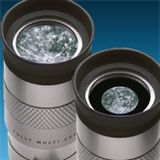
When it comes to buying or using a telescope, there are a lot of strange terms to learn. Not all of them are critical to actually using a telescope, but most will help you better understand your telescope and how it works. One of these terms is focal length.
Generally expressed, focal length is the distance (given in millimeters) between the telescope's primary lens or mirror and the point where the light rays come together in focus. Why is this important? Focal length is the major determining factor of any given telescope's magnifying power. You might think that using a lot of magnification would be a bonus when looking at a small object, but all telescopes have a practical limit. At lower magnifications, the image is small, bright and well-resolved, but too much magnification makes for nothing more than a big, blurry image. Why? Telescopes can only gather so much light and high magnification means you're just spreading that same amount of light over a larger area - resulting in useless or "empty" magnification. So how do you determine a telescope's practical magnification limits? It's easy. Just multiply the objective lens or mirror's diameter (in millimeters) by 2. For example, a 100mm telescope would have a practical magnification limit of 200X.
Knowing your telescope's limitations will help you to choose accessories, such as eyepieces and barlow lenses wisely. First let's learn about a telescope's focal length, and then we'll look at eyepiece focal length.
How To Determine A Telescope's Focal Length
Most telescopes list the focal length in the manufacturer specifications. However, there might be a circumstance where you don't have access to this information. So what do you do if you have a mystery telescope? There are two ways to get a rough idea if you have some information. It might be printed on the telescope's body or perhaps on an instruction manual or box. If you have the telescope's focal ratio (f/number) you can measure the diameter of its primary optic - either the large mirror for a reflector telescope, or the large lens of a refractor telescope. Now, multiply the focal ratio by the diameter of its primary optic. Viola. You now know the telescope's focal length. The second method is if you know the magnifying power of your telescope. This circumstance might occur if you have a telescope or spotting scope with a known, fixed eyepiece. Look for any marking which might tell you it has a specific magnifying factor. If you have this value, then you can multiply the focal length of eyepiece by the magnification. This will also give you the focal length of the telescope.
You can also determine the focal length of a reflector telescope in another manner, but you'll have to remove the mirror (This method is very risky and could void your telescope's warranty). Chances are you'll only use this method if you encounter a home-made reflector telescope or an old one which no longer has an instruction manual. Carefully mount the mirror so it is held securely vertical and place it in a darkened room. From the other side of the room, shine a flashlight on the mirror and place an impromptu projection screen between the two - slightly off to one side. Move the screen until the light is focused in the smallest possible point. Mark that distance and measure it. Now, divide that measurement number by two to determine the focal length.
How To Determine Your Telescope's Magnifying Power
Now that you understand the importance of your telescope's focal length, you can determine the magnifying power of any eyepiece you use in it. All it takes is a little math. Take a close look at your telescope's eyepieces and you'll see they also have a focal length. It is usually printed on the barrel and it is also expressed in millimeters. All you need to do is divide the focal length of the telescope by the focal length of the eyepiece. For example, if you have a telescope that has a 1000mm focal length and you are using a 20mm eyepiece, you will be getting 50X (1000mm/20mm = 50X). If you place a 20mm eyepiece in a telescope with a 500mm focal length, you'll get 25X (500mm/20mm = 25x). That is why the same eyepiece appears to behave differently in different telescopes! As we learned earlier, there are practical limitations to a telescope's magnifying power, so choose, and use your eyepieces by focal length accordingly.
Magnification can be a wonderful thing. It can reveal amazing planetary features, subtle details in nebula and galaxies, split tight double stars and make you feel like you are walking on the Moon. However, high magnification also has some drawbacks. If you aren't using a telescope with a drive unit, you will constantly have to use your slow motion controls to "track" your subject as the Earth moves. This can be very frustrating when viewing. Also, when you magnify, you are magnifying sky conditions (How to Judge Sky Conditions). For example, if you are using 200X on a night with poor clarity and stability, you are magnifying those conditions two hundred times as well. Just remember your telescope's practical limits and how to determine its magnification - and enjoy pushing those limits on good nights!


















